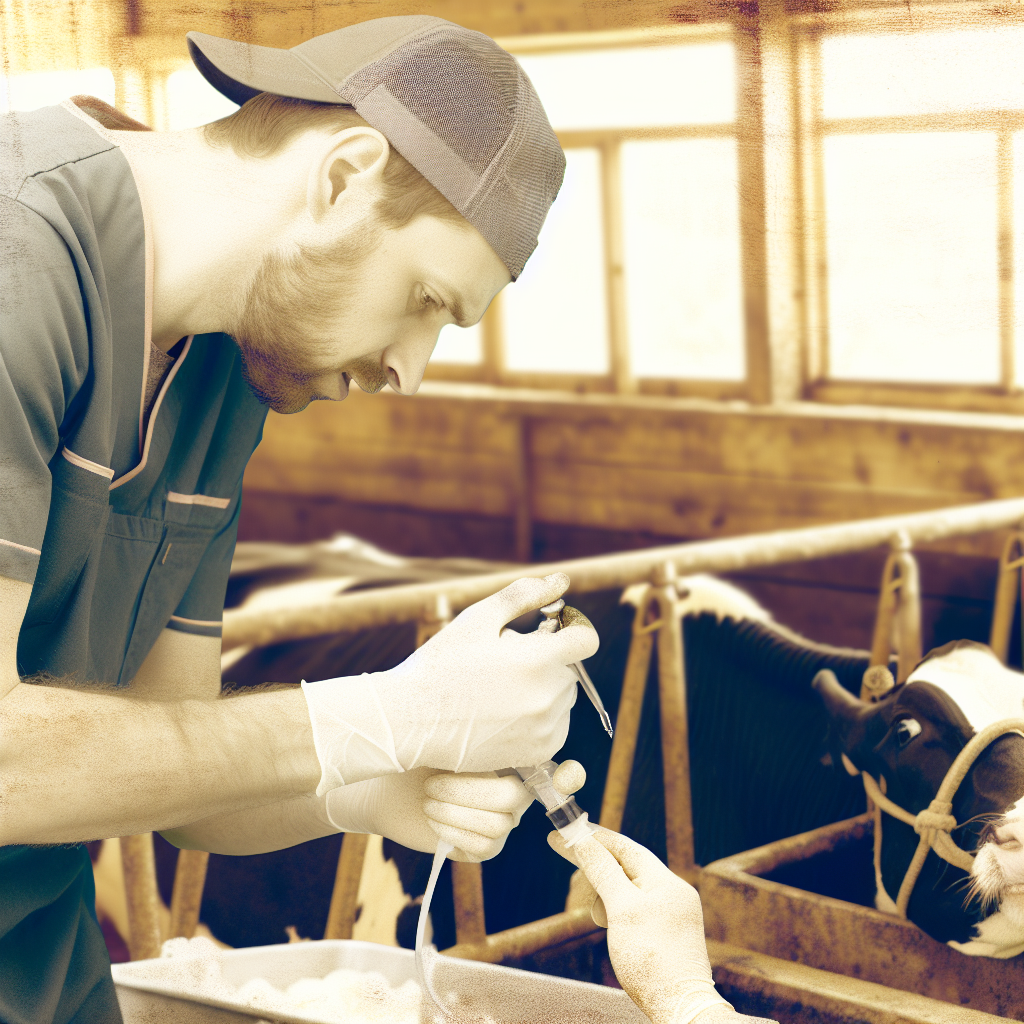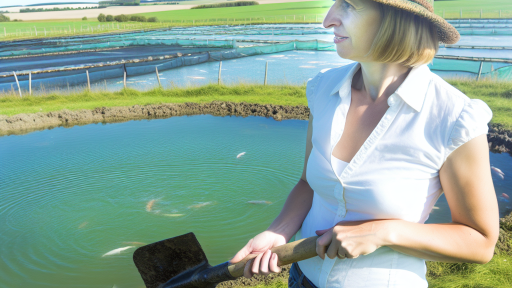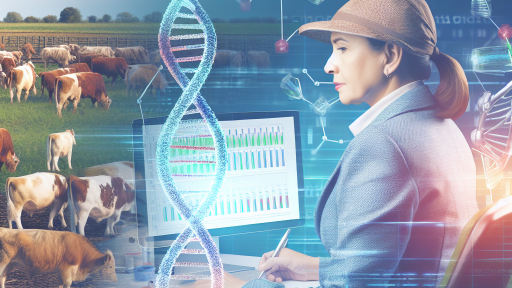Introduction to Artificial Insemination in Livestock
Artificial insemination (AI) transforms livestock breeding practices.
This technique allows farmers to enhance genetics in their herds easily.
It eliminates the need for physical presence of bulls or boars.
Farmers can access superior genetics through AI.
Moreover, AI significantly reduces potential disease transmission between animals.
The technique is widely adopted in dairy and beef industries.
This adoption stems from AI’s efficiency and effectiveness.
Farmers can control breeding timing more precisely with AI.
Consequently, this method leads to more uniform offspring.
Additionally, it allows for better planning of breeding cycles.
Farmers can manage breeding without the costs of maintaining a male animal.
The process ensures better use of resources and is cost-effective.
AI also opens doors for using frozen semen from distant locations.
This access broadens the genetic pool significantly.
Farmers can select specific traits in livestock to improve performance.
Transform Your Agribusiness
Unlock your farm's potential with expert advice tailored to your needs. Get actionable steps that drive real results.
Get StartedAs a result, there is a noticeable increase in productivity and profitability.
Furthermore, AI improves the overall health of livestock populations.
It enables controlled breeding to avoid inbreeding issues.
Overall, AI in livestock offers substantial benefits.
These advantages support modern agricultural practices and sustainability goals.
Increased Genetic Improvement
Advantages of Selective Breeding
Artificial insemination enhances genetic improvement in livestock significantly.
This technique allows farmers to breed animals with desirable traits.
Furthermore, it introduces superior genetics into herds with ease.
Selective breeding improves traits such as growth rate, milk production, and disease resistance.
As a result, livestock becomes more productive and resilient over time.
Farmers can select from a wider genetic pool than traditional breeding allows.
This wider selection leads to healthier animals overall.
Additionally, it reduces the risk of genetic diseases.
Through careful selection, farmers can eliminate inherited disorders.
This process helps maintain herd health and longevity.
Efficiency in Breeding Programs
Artificial insemination improves the efficiency of breeding programs.
It eliminates the need for transporting animals for breeding purposes.
Farmers can inseminate multiple females with a single bull’s semen collection.
This approach saves time and reduces costs associated with breeding logistics.
Moreover, it allows for better synchronization of breeding cycles.
As a result, farmers can achieve consistent calving or lambing dates.
This uniformity benefits herd management and planning significantly.
Enhanced Record-Keeping and Data Analysis
Implementing artificial insemination facilitates better record-keeping.
Farmers can track genetic lines and performance data more effectively.
Showcase Your Farming Business
Publish your professional farming services profile on our blog for a one-time fee of $200 and reach a dedicated audience of farmers and agribusiness owners.
Publish Your ProfileThis data aids in making informed breeding decisions in the future.
Moreover, it allows for precise comparison of offspring performance.
Such analysis leads to continuous improvement in breeding programs.
Consequently, livestock quality and productivity continue to rise over time.
Cost-Effectiveness Compared to Traditional Breeding Methods
Initial Investment and Operation Costs
Artificial insemination (AI) lowers initial investment costs significantly.
Farmers do not need to purchase and maintain a breeding bull.
Additionally, AI eliminates expenses related to bull housing and feeding.
Ongoing operational costs remain lower than traditional breeding methods.
Efficiency and Time Savings
AI improves the efficiency of the breeding process.
It allows for the use of superior genetics across multiple herds.
Furthermore, AI reduces the time spent on managing natural breeding cycles.
This efficiency translates into quicker herd improvements.
Increased Genetic Diversity
Artificial insemination enhances genetic diversity within livestock populations.
Farmers can access a wider gene pool without geographical limitations.
This access helps in creating healthier, more resilient animals.
Moreover, increased diversity can lead to better disease resistance.
Higher Pregnancy Rates
AI typically results in higher pregnancy rates compared to natural breeding.
Using advanced techniques ensures optimal timing of insemination.
Trained professionals can improve insemination success significantly.
Higher success rates reduce the need for repeated breeding efforts.
Health Management Benefits
AI helps maintain better overall herd health management.
It reduces the risk of sexually transmitted diseases that may occur with natural breeding.
Without bulls on-site, farmers can prevent unwanted injuries to livestock.
This results in healthier animals and reduces veterinary costs.
Benefits of Artificial Insemination
Artificial insemination stands out as a cost-effective solution for livestock breeding.
It offers numerous advantages over traditional breeding methods.
Farmers can benefit from increased efficiency, higher profitability, and improved herd quality.
Discover More: Sustainable Livestock Farming: Balancing Animal Welfare and Profit
Disease Control: Reducing Transmission Risks in Livestock
Enhanced Biosecurity Measures
Artificial insemination reinforces biosecurity in livestock management.
It reduces direct contact between animals, minimizing disease spread.
This technique helps maintain healthier herds and flocks overall.
As a result, farmers see improved productivity and reduced veterinary costs.
Management of Genetic Disease
By utilizing artificial insemination, farmers can select healthy sires intentionally.
This selection process allows for the avoidance of genetic diseases.
Consequently, breeding programs can focus on eliminating specific health risks.
Healthier breeding stock leads to stronger and more resilient animals.
Control Over Disease Outbreaks
Artificial insemination aids in managing disease outbreaks effectively.
Farmers can rapidly adjust breeding strategies in response to an outbreak.
This adaptability ensures the herd’s genetic diversity remains intact.
Moreover, it allows for continued herd expansion without increasing risk.
Showcase Your Farming Business
Publish your professional farming services profile on our blog for a one-time fee of $200 and reach a dedicated audience of farmers and agribusiness owners.
Publish Your ProfileVaccination and Health Protocols Integration
Artificial insemination can be combined with comprehensive health protocols.
Farmers can implement vaccination schedules tailored to breeding cycles.
This integration ensures that all animals receive appropriate health measures.
Thus, it maximizes herd immunity and reduces disease prevalence.
Long-term Health Benefits
Over time, artificial insemination fosters stronger and healthier livestock populations.
It contributes to sustainable farming practices and animal welfare.
Farmers observe decreased morbidity and mortality rates among livestock.
Ultimately, this leads to greater economic viability in farming.
Uncover the Details: Advanced Breeding Technologies for Modern Farmers
Enhanced Reproductive Efficiency
Higher Conception Rates
Artificial insemination increases conception rates in livestock.
This method allows farmers to select superior genetics.
By using semen from high-quality sires, breeders can enhance offspring traits.
Moreover, it shortens the time required for breeding cycles.
As a result, livestock herds can expand more rapidly.
Improved Genetic Diversity
Artificial insemination also boosts genetic diversity within herds.
Farmers can source semen from various breeds without geographical limits.
This practice reduces inbreeding and associated health issues.
It contributes to the overall resilience of livestock populations.
Cost Efficiency
Employing artificial insemination can be a cost-effective solution for farmers.
Traveling to a bull for natural breeding can be expensive.
Artificial insemination eliminates these transportation costs.
Additionally, it decreases the risk of breeding-related injuries.
Control Over Breeding Management
Farmers have greater control over their breeding management with artificial insemination.
They can plan and time inseminations for optimal results.
This precision leads to higher success rates.
Moreover, it allows for better record-keeping and analysis.
Uncover the Details: Key Genetic Traits to Consider in Breeding
Access to Superior Genetics: Global Sourcing of Semen
Enhancing Genetic Diversity
Artificial insemination provides farmers with access to diverse genetics.
This practice reduces the risks associated with inbreeding.
Breeders can select traits that enhance productivity and resilience.
Consequently, livestock with superior genetics thrive better in various conditions.
Global Sourcing Opportunities
Farmers can source semen from renowned bulls worldwide.
This expands their choices beyond local gene pools.
Accessing international genetics leads to improved herd performance.
For example, dairy producers can select high-yielding sires from specific countries.
Cost-Effective Breeding Solutions
Artificial insemination often proves more economical than live breeding.
Traveling to breed with top sires incurs significant costs.
By utilizing frozen semen, farms can save on logistics and expenses.
Additionally, this method reduces the need for maintaining male animals.
Improved Health and Disease Resistance
Accessing superior genetics can enhance the overall health of livestock.
Showcase Your Farming Business
Publish your professional farming services profile on our blog for a one-time fee of $200 and reach a dedicated audience of farmers and agribusiness owners.
Publish Your ProfileFarmers can select animals with higher disease resistance.
This promotes a healthier herd and reduces veterinary costs.
Consequently, herds become more productive over time.
Flexibility and Control in Breeding
Farmers gain greater control over their breeding programs.
They can implement strategic breeding plans tailored to specific goals.
Additionally, artificial insemination allows for better timing of breeding.
This results in improved odds of successful pregnancies.
See Related Content: Revolutionary Livestock Management Tools Every Farmer Should Know

Flexibility and Convenience in Breeding Management
Enhanced Breeding Scheduling
Artificial insemination (AI) allows for precise control over breeding times.
This precision enhances the overall scheduling of breeding activities.
As a result, farmers can optimize their herd’s genetic potential more effectively.
Additionally, proper timing plays a crucial role in successful conception rates.
Access to Superior Genetics
With AI, livestock farmers can access elite genetics from remote locations.
This access broadens the genetic diversity within herds significantly.
Farmers can implement selective breeding programs to produce high-quality offspring.
Furthermore, it allows for the introduction of traits that improve productivity.
Minimized Disease Risk
Utilizing AI reduces the need for physical contact between animals.
This minimizes the spread of infectious diseases among herds.
Consequently, herd health management becomes more streamlined.
Farmers can focus on maintaining overall health and wellness in their livestock.
Cost Efficiency
AI can significantly lower operating costs in livestock production.
Farmers save on costs associated with keeping bulls for natural breeding.
Moreover, AI reduces the need for transportation and housing of breeding stock.
This method provides a cost-effective solution for improving herd genetics.
Improved Record Keeping
The implementation of AI enhances data collection regarding breeding practices.
Farmers can track lineage and reproductive performance more effectively.
As a result, making informed decisions becomes simpler and more efficient.
Comprehensive records can also aid in identifying successful breeding strategies.
Improving Overall Herd Health and Productivity
Enhanced Genetic Selection
Artificial insemination allows farmers to select superior genetics for breeding.
This process improves herd characteristics in various desirable traits.
For example, disease resistance and growth rates can significantly increase.
Additionally, access to top-quality semen expands genetic diversity.
Increased Fertility Rates
With artificial insemination, fertility rates often improve over natural breeding.
Farmers can synchronize breeding cycles for better timing.
Furthermore, successful conception rates enhance overall herd productivity.
Reduction of Disease Risk
Using artificial insemination minimizes the risk of spreading venereal diseases.
By controlling the breeding environment, farmers reduce health complications.
Clean techniques contribute to a healthier herd in the long run.
Cost-Effectiveness
Artificial insemination can be more cost-effective than traditional breeding.
Farmers save on bull maintenance and feed costs over time.
Showcase Your Farming Business
Publish your professional farming services profile on our blog for a one-time fee of $200 and reach a dedicated audience of farmers and agribusiness owners.
Publish Your ProfileThis method also reduces the need for purchasing and housing bulls.
Flexibility and Convenience
Artificial insemination provides farmers with flexibility in breeding schedules.
They can inseminate at their convenience without needing a bull present.
Moreover, this method is suitable for managing small farms efficiently.
Challenges and Considerations in Implementing Artificial Insemination
Understanding the Complexity
Artificial insemination (AI) is a complex procedure that requires skill.
Training personnel is essential for successful implementation.
Moreover, this complexity may deter some farmers from adopting AI.
Cost Implications
Implementing AI can be financially demanding for livestock operations.
The initial costs for equipment and training can be high.
Additionally, ongoing expenses for maintenance and supplies must be considered.
Animal Health Considerations
Monitoring the health of animals during the AI process is crucial.
In some cases, complications may arise post-insemination.
Veterinary support is often necessary to address any health issues.
Success Rates and Timing
Success rates of AI can vary widely based on several factors.
The timing of insemination relative to estrus is critical for success.
Farmers must monitor cycles closely to improve outcomes.
Regulatory and Ethical Issues
Navigating the legal landscape around AI is essential for compliance.
Farmers must be aware of regulations regarding genetic material use.
Ethical considerations also come into play regarding animal welfare.
Adoption and Acceptance Challenges
Some farmers may resist adopting AI due to tradition.
There can be a lack of understanding about the technique’s benefits.
Education and outreach can help mitigate these resistance factors.
Technological Advancements
The field of AI is rapidly evolving with new technologies.
Keeping up with advancements can be a challenge for some producers.
Investing in modern technology can greatly enhance effectiveness.
Additional Resources
Livestock Production & Management | Ohio State ATI
Sources, Trends, and Drivers of U.S. Dairy Productivity and Efficiency




